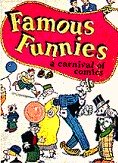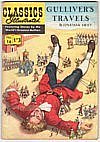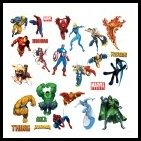Comic Books, Then and Now!
Comic books have been around for as long as I can remember. Have you ever wondered how they got their start? Why has this form of printed literature become so popular?
A brief history

The first regularly published comic in the more recognizable modern format was Famous Funnies in the early 1930s. It featured such greats as Joe Palooka, Buck Rogers and Mutt and Jeff.
Max C. Gaines was one of the early giants of the 1930s comic book industry. He made his industry mark when he worked for the McClure Syndicate. There, Gaines used the color presses to produce Dell Comics. Advised by his friend, Shelton Myers, he passed on one bit of advice to Dell: Publish Superman! Gaines went on to launch All- American Comics, Flash Comics, and Sensation Comics before he founded his own company, EC (Educational Comics), which specialized in Bible Stories. When he died, his son made history by developing some of the most renowned and notorious horror and mystery comics as well as Mad Magazine. The former "Educational Comics" had now become Entertainment Comics, or EC Comics.
It was Max C. Gaines, the father, who brought "Superman" to Dell's publisher, Harry Donenfield. Donenfield scored the comic coup of the century when he published a story written by two teenagers, Jerry Siegel and Joe Shuster- and so "Superman of Metropolis" (the title of their short story they wrote in their own fanzine) was born. Superman was to set a standard for superheroes that persist to this day. A more in depth history can be found in my new ebook called "Comic Book Collecting, A Starting Point".Personally I can not leave out some of my favorites as a child, which was "Classics Illustrated", while talking about history.

Albert L. Kanter was the first publisher to recognize the comic-book medium as a new way to introduce children to the great classics of literature. The publication of Classic Comics 1, a 64-page adaptation of Alexandre Dumas' "The Three Musketeers" in October 1941, began one of the most successful experiments in the comic-book industry. The series struggled for several years though, with irregular schedules and numerous printers. The page count was reduced to 56 with number 13, and again to 48 with number 45, which became the new standard. The Jerry Iger Shop began producing Classic Comics beginning with number 23 in 1945. The title changed to Classics Illustrated with number 35.
Henry Kiefer and Alex Blum created much of the artwork in the early days. In 1951, Classics Illustrated introduced painted rather than line- drawn covers, and moved to the major national distributor, Curtis. Curtis's price hike from 10 to 15 cents did not slow the growth of the series because of its marketing as books, not comics. The respectability of the series also helped it survive the comic-book witch- hunts (see article under "And with the good, comes also, the bad") of the 1950s while many other publishers were forced to fold. There was never any need for the series to seek the imprimatur of the Comics Code Authority seal.
The production of new titles ceased in 1962 with number 167, Faust. The demise of the series was due to a combination of the loss of the publisher's second-class mailing permit and external factors such as television, cheap paperback books, and Cliff's notes. Foreign publication continued though, and several US revivals have been attempted, most notably First Publishing's 1990 series.
Classics Illustrated have been issued in reprints since 1943. Changes in book length, covers and interior artwork have led to a bewildering number of variations. In all, there are nearly 1400 different editions of the US series alone! Editions are most reliably distinguished by the highest reorder number (HRN) in the list usually found on an inside cover. Writers and artists are usually unaccredited and frequently unknown.
[Information about the history of Classics Illustrated was adapted from "Understanding Classics Illustrated" by Dan Malan in The Overstreet Comic Book Price Guide (23rd Edition), by Robert M. Overstreet, Avon Books (1993).] Note: This invaluable information must also be credited to John P. Selegue and F. James Holler of www.uky.edu/Projects/Chemcomics.
It appears that back issues of Classics Illustrated can become somewhat elusive to track down. So hopefully, you may find what you are looking for at eBay up above.
Although, not for everyone, in my opinion, Classics Illustrated were some of the most profound and entertaining magazines in the comicbook industry.
And with the good, comes also, the bad
I have paraphrased and combine two rather informative articles, one by Edward Pontee and the other by John Byrne, on some of the trials and tribulations the industry has seen. Read the in depth article here.Comic books proliferated during the 1930s and 1940s. Exciting characters came into being and wildly entertaining adventures were to be had. Individuals and children alike could escape the humdrum of day to day life and let their imaginations soar for a few hours while absorbing themselves in adventure.
Comics and comic-book-collecting apparently started gaining real momentum through the 1950s and 1960s. Even with the advent of the "witch-hunts" of the 1950s, as described in the article above. There is still a gigantic appeal to the romance and adventure contained throughout the pages of The Comic Book today.
Comics Books Today
Although there is a plethora of information on the history of comic books, I have just touched on some of the more interesting aspects to me. There are more resources available on my interesting links page.
I would like to comment a little on comic books today and where they may be obtained. Gone are the days when I used to be able to purchase comic books for 10 or 12 cents down at the local department store or even the grocery store. When I do find comic books in the local book stores now, they are generally $3.00 to $5.00 apiece. Isn't inflation a great thing!
But now with the age of the Internet, it has become a lot easier to find and purchase yearly subscriptions, which do bring the cost per magazine down quite drastically.
Of course there is always Amazon for comics (click the image below). Beware though, you may be surfing all day, looking at all the neat stuff. Just be sure to come back here to my site and keep up on comic information.
Comic-book-characters:


Some of the more interesting comic book characters have endured over the years. Comic-book publishers like Marvel, DC Comics, Dell, etc. have produced and maintained such staples as Superman, Batman, and Wonder Woman, which have thrilled and entertained readers for 70 years or more. One of my favorites,The Fantastic Four, which came about not too many years later, kept my imagination racing during my younger years. To this day, I can still remember the catch phrase "Flame On" as Johnny, the human torch, went into action.
It seems these days,X-Menand Spiderman have taken the industry by storm, only to be followed by Catwoman and the Thundercats. Whatever your interest, there is no lack of comic-book characters or super powers. Just follow the links above for a little general information on each character. Most of these comic book characters should be a welcome addition to anyone's comic book collection.
Back to the top of Comic Books page!










New! Comments
Have your say about what you just read! Leave me a comment in the box below.